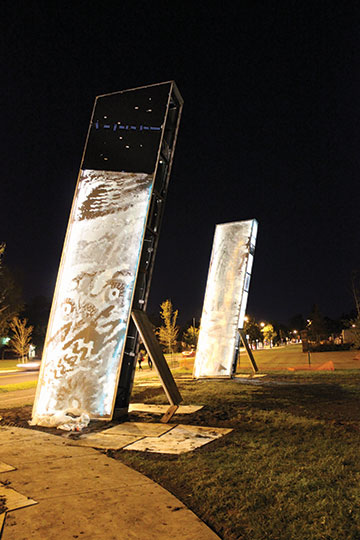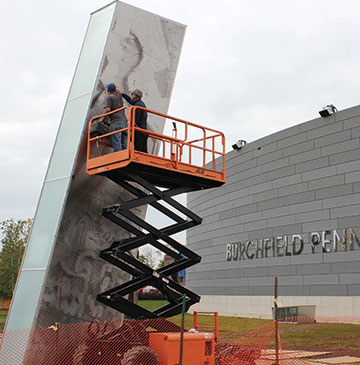The Burchfield's New Front Yard
by Geoff Kelly

A rare and monumental collaboration between UB and Buffalo State faculty, staff, and students will be unveiled Friday
This Friday, the Burchfield-Penney Art Center will switch on a new, permanent installation that will forever alter the building’s profile and the streetscape: At dusk, a community street party will culminate in the activation of a three-screen video projection and audio system that will run in perpetuity, featuring work by local and international media artists.
The Burchfield Penney is billing the Front Yard as “the world’s first permanent, environmentally-responsive, 24/7/365, outdoor new media gallery,” and indeed it is unique: In addition to the fact that it will permanently transform the long, gray wall of the center facing Elmwood into a projection surface, sensors on a weather tower will read environmental conditions—temperature, humidity, wind speed and direction, precipitation—and summon corresponding images and sounds. This sensitivity to weather is an homage to Charles Burchfield, the center’s namesake, whose work dealt extensively with changes in seasons and climate.
But what makes this installation even more unusual in art world is that it is both an art project itself and a permanent, changeable tool with which other artists can work.
“The openhandedness of what Brian and Brad have done, the generosity of it, is unique,” says Anthony Bannon, the Burchfield Penney’s executive director, in describing the project, which is a collaboration between architect Brad Wales and his Small Built Projects class at the University at Buffalo and video artist Brian Milbrand, who is technical director for Buffalo State College’s Communications Department. “Their art is to create the means for others to make art.
“Essentially what we’ve done is to build a system for the algorithm that becomes an artist’s pallette.”

The proposal
Wales and Milbrand have worked together extensively in recent years on art projects incorporating video, sound, performance, and specially constructed spaces, including works at Gallery 164 (Story of a Girl, The Cellphone Show, Temporary Dream, radioACTIVE, Gross Negligence 1 & 2), at Babeville (surround) at Buffalo State (People’s Hearing on Fracking, VIDEOSOUNDDANCEMAGIC), and at Silo City (American Grain).
In 2008, Wales approached Milbrand about collaborating on a submission to a public art competition sponsored by the Burchfield Penney, which was about to open its new, state-of-the-art building and was looking for ways to complement its exterior.
Called Cycles, the project they submitted comprised a three-channel video ampitheater that would reflect Burchfield’s interest in the seasonal cycles. Though Cycles won the competition, in a field of 46 entries, the project went no further until last fall. By that time, the concept had changed: Instead of a free-standing set of screens, the Burchfield Penney was interested in making the building itself the projection surface.
In this iteration, which would be called Cycles 2, the project would require a different kind of infrastructure: three projection towers, as slim and visually transparent as possible, elegantly designed and complementary to the building, with water-tight, heated enclosures for the projectors and computers. In response, Wales ran a design charette with the students in his Small Built Works class at UB’s School of Architecture & Panning, which for 12 years has been designing and creating projects in the city: bus shelters, sculptures, and parkspace, among others.
The students’ designs for the projection towers became part of a larger proposal that was presented to Bannon, who had just assumed his role as the Burchfield Penney’s new executive director.
Bannon’s response to the proposal was easy, he says: “Yes. This is a perfect idea. Let’s go for it.” Here was an opportunity, Bannon explains, to create something on the same high level—“an international leadership project”—as the Gwathmey Siegel designed building that would host it. As well, the project built on a long local tradition of innovation in the use of audio and visual technology in the arts, from Wurlitzer to Moog to Woody and Steina Vasulka, from Creative Associates to Hallwalls, Squeaky Wheel, and the Burchfield Penney itself.
Bannon brought Wales, Milbrand, and the UB students back to make their presentation to his board of directors, who approved the project. And then the real work began.

Fabrication and installation
The Small Built Works students offered a number of appealing designs for the towers, but the winning design belonged to Isabella Brito, a Brazilian student with whom Wales worked to fine-tune the final product.
“Isabella Brito had an inspired concept,” Wales says. “She stayed on in Buffalo and worked with us professionally to create the permit and fabrication drawings. And like all our Small Built Works Projects, Mike Pratt donated structural engineering.”
“The core idea for the towers’ design was to create a piece that worked harmoniously in composition with the architecture of the Burchfield Penney,” Brito says. “This leads to the minimal geometry, with a slight angle leaning towards the building.”
The space required for the computers and projectors inside the towers, and the need of enough space for a person to climb up inside to do maintenance, demanded the towers to be large in cross-section.
“This characteristic would cause some visual interference with the building,” Brito says. “The way to solve this problem was to incorporate information on the elevations that would look bulky, nd Burchfield paintings seemed to be a natural solution.”
The towers are clad in stainless steel perforated with laser-cut holes—about 120,000 of them—which, backlit by LEDs, turn the towers into light-boxes portraying details from Burchfield paintings.
“The interest of Charles Burchfield on the cycles of the seasons led me to choose, along with the art center staff, the works The Moth and the Thunderclap, Wind Blown Asters, and Oncoming Spring, each to represent summer, spring, and winter,” Brito says.
Rigidized Metals provided all the custom stainless steel on the project, Wales says. “They were incredible in producing this unique work very quickly and to extremely high quality standards. Rick Smith and Kevin Fuller were great in making this happen.”
The process of transforming watercolor paintings into a dot pattern to be perforated on stainless steel panels comprised many steps, including the generation of a high-contrast, gray-scale version of the Burchfield works. “This proved to be a challenge, as colors that would be easily set apart in the original paintings would look similar in gray-scale—look at the yellow and pink in Wind Blown Asters, Brito says. “It was a manual process, to make each section look as vibrant and lively as the original paintings. The gray-scale images were then transformed into a dot pattern, or a half-tone pattern. Each circle was manually drafted, a task that demanded several hours.”
The structures underneath the panels were built at UB by Wales, Charlie Schmidt, Hanna Ihrke, Scott Swiezy, and Wade Georgi, a former thesis student under Wales. “Wade made superhuman efforts to build the structures, basically willing the project into existence,” Wales says. They were helped by mechanics from LP Ciminelli, who also installed the finished structures on-site at the Burchfield Penney.
Wales has a long list of people to thank, in addition to those already mentioned: UB School of Architecture & Planning chair Omar Khan; the school’s dean, Robert Shibley, a major in-kind donor; AV Solutions; electrician Greg McCabe; and Brian Witmer and Steve Shaeffer at Buffalo State Facilities, among others.
“Everyone at the Burchfield has been amazing—Don Metz, John Malinowski, Scott Propeack, and especially Tony Bannon, who really saw the potential in the project,” Wales says. “The Burchfield has made a bold, visionary curatorial decision that will enrich the city for many years.
“And, of course, I have to give props to my partner Brian Milbrand. We’ve done many shows together but this will be the one that has the longest-lasting impact on Buffalo.”
It is also likely to be the highest-profile legacy of the Small Built Works class. Wales and his students have put that workshop on hiatus, and instead are focusing on creating an entry in the 2015 Solar Decathlon, a contest sponsored by the US Department of Energy that challenges collegiate teams to design, build, and operate solar-powered houses that are cost-effective, energy-efficient, and attractive.
The unveiling
While Wales and his students designed and built the infrastructure, Milbrand worked on the technological and curatorial aspects.
“I’ve always been interested in Buffalo’s dramatic cycles of the seasons, and how we shift from season to season, a similar curiosity to that of Charles Burchfield,” Milbrand said in an artist’s statement. “Bringing public video art to this region is also a passion that I wanted to create with the talented media artists with whom I collaborate. Avant-garde audio, film, and video productions flood out of Western New York, and all the practitioners are presenting very experimental and challenging work.”
Milbrand likens Friday’s unveiling to a baby being born: As time passes, the databases will collect more information—from the weather tower designed with help from Buffalo Lab’s George Hampton, and from cameras mounted on the building that will take in everything they see—and that information will be cycled through the installation’s computers and its projectors. “Eventually it will become a toddler, then a teenager, then a grownup,” Milbrand says.
Like the design and fabrication of the towers, the programming has been a collaborative effort, in which Milbrand relied especially on artists J. T. Rinker and John F. Bono, as well as programmer Paul Visco. “They mae this project much better than I imagined it could be,” Milbrand says.
Friday’s unveiling will feature a premier of Milbrand’s Afterglow Arrangements, as well as video works by Steina, Hollis Frampton, Paul Sharits, Meg Knowles and Chris Gallant, Barbara Lattanzi, and continue through the month with works by Bono, Dorothea Braemer, Andrew Deutsch, Courtney Grim, Carl Lee, Cort Lippe, Vince Mistretta, Jan Nagle, Rebekkah Palov, John Toth, David Tudor, Anna Scime, and Rinker, whose work will play the sunrise. There will be music by DME, led by Buffalo State’s Tomás Henriques. And, because it’s an outdoor Buffalo art party, there will be a host of food trucks on hand.
blog comments powered by Disqus|
Issue Navigation> Issue Index > v12n42 (Week of Thursday, October 17) > The Burchfield's New Front Yard This Week's Issue • Artvoice Daily • Artvoice TV • Events Calendar • Classifieds |









 Current Issue
Current Issue